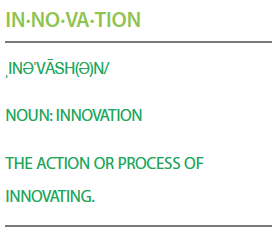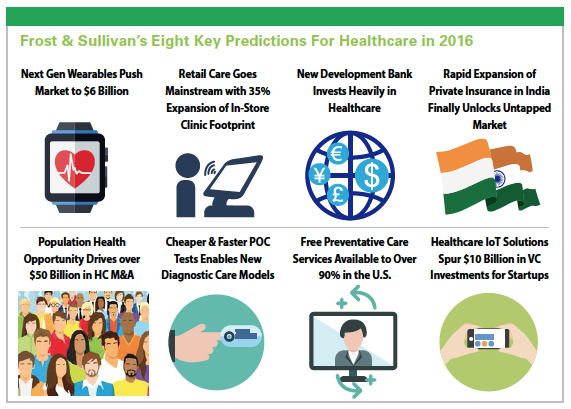Innovation — change, alteration, revolution, upheaval, transformation, metamorphosis, breakthrough — no matter how one defines this metaissue, innovation is disrupting the healthcare ecosystem and challenging CEOs, R&D experts, marketers, patient advocates, basically all stakeholders, to rethink how they do business.
Experts say 2016 is poised to be impacted by healthcare transformations. According to Frost & Sullivan’s VP of Life Sciences Nitin Naik, several new demand spaces such as innovative therapeutics (immuno-oncology), biosimilars, and regenerative medicine (cell therapy) have emerged, at the same time pharmaceutical companies are sharpening their long-term positions.
“Fundamental behavioral shifts in these spaces are redefining the market, forcing companies to adopt a beyond-the-pill approach and increase investments in innovations related to supply chain, mHealth, and digital marketing channels.
 “Immense market opportunities are on the horizon for the in-vitro diagnostics market participants as they look to increasingly focus on technologies that promote decentralization," Mr. Naik says. “With healthcare becoming more consumer-centric healthcare systems, payers, and providers are looking to invest in digital strategies to improve the cost effectiveness of this $58.2 billion industry. Under the heavily consolidating industry, companies must be ready to capture these opportunities and focus on the hot buttons in 2016. Major investment areas include liquid biopsy, next generation sequencing, companion diagnostics, and molecular point of care testing technologies."
“Immense market opportunities are on the horizon for the in-vitro diagnostics market participants as they look to increasingly focus on technologies that promote decentralization," Mr. Naik says. “With healthcare becoming more consumer-centric healthcare systems, payers, and providers are looking to invest in digital strategies to improve the cost effectiveness of this $58.2 billion industry. Under the heavily consolidating industry, companies must be ready to capture these opportunities and focus on the hot buttons in 2016. Major investment areas include liquid biopsy, next generation sequencing, companion diagnostics, and molecular point of care testing technologies."
According to KPMG, first-movers — companies that are introducing products and capabilities faster than the average — stand to reap big rewards in the form of larger market share, lower development costs, and the perception of being trendsetter. By understanding technology solutions currently in the pipeline as well as their potential to disrupt how healthcare is delivered, providers can be well-prepared to integrate them once they hit the market. Two categories of technology — patient monitoring and new treatments — hold particular promise.
Implantable monitoring capabilities courtesy of nanotechnology are fueling the imagination of providers.
“This sounds sci-fi, but the technology is on its way — though it may take a number of years before the economics make sense," says Richard Bakalar, M.D., of KPMG International’s Global Healthcare Center of Excellence and managing director with KPMG in the U.S.
“Once the cost comes down, implantables could one day do what sonographic imaging did for surgery decades ago — allow doctors to see what’s going on inside a patient before going in surgically. Nanotechnology is taking it down another level, to the cellular and molecular. There’s a big cost-avoidance here in the long run, but it will take time."
Nanotech could also enable tracking chronic problems from the inside — for example, if a doctor can place a pin with a sensor in a bone, the sensor could track its health or degeneration, and alert doctors to “the point of no return, where surgery is necessary," says Ashraf Shehata, KPMG International’s Global Healthcare Center of Excellence and principal with KPMG in the United States. “Pins could detect degradation of tissue. It’s about taking technologies and combining with things we’re doing today."
He adds that the key will be to combine the therapeutic and diagnostic aspects of nanosensors.
 The second area of note according to KPMG analysts is new treatments. Disruptive technologies such as 3D printing are quickly being adapted for healthcare, with the greatest promise in three categories: prosthetics, medical devices, and human tissue. The concept of printing tissues — and even whole organs — is becoming more viable and could be a game changer, say experts.
The second area of note according to KPMG analysts is new treatments. Disruptive technologies such as 3D printing are quickly being adapted for healthcare, with the greatest promise in three categories: prosthetics, medical devices, and human tissue. The concept of printing tissues — and even whole organs — is becoming more viable and could be a game changer, say experts.
Mr. Shehata adds that he can envision an entire “remote printing industry" in the future, where a printing facility will “print medical devices, implantables, and circuit boards that are personalized."
In five years, healthcare may look different but there are some hurdles to overcome. It’s clearly not just a matter of advancing technology and gathering data: it’s about creating the policies and the infrastructure to support the changes that we want to come. And this will take the main players working together to make it happen.
 “The other part I’d like to see is discussions between service providers, which are building infrastructure, and manufacturers, like HP, Cisco, and Intel," Mr. Shehata says. “All are parties that need to come to the table to build a scalable model. As we’ve seen with big data, it’s not good enough just to do it fast or to do it cheap. With healthcare, it has to be both — and it has to be appropriate. And with time, these variables will, eventually, intersect."
“The other part I’d like to see is discussions between service providers, which are building infrastructure, and manufacturers, like HP, Cisco, and Intel," Mr. Shehata says. “All are parties that need to come to the table to build a scalable model. As we’ve seen with big data, it’s not good enough just to do it fast or to do it cheap. With healthcare, it has to be both — and it has to be appropriate. And with time, these variables will, eventually, intersect."
PharmaVOICE is celebrating innovation with this special issue, in which more than 175 industry experts provide their insights on a wide range of topics, including how innovation drives value, the importance of an innovative corporate culture, the constraints that prevent innovative thinking, breakthrough products, and innovation as a sustainable business model. Additionally, we look at incentives, financing, hubs of excellence, and companies to watch. (PV)
Please visit our digital edition at www.pharmavoice.com to read exclusive original bonus content.


















